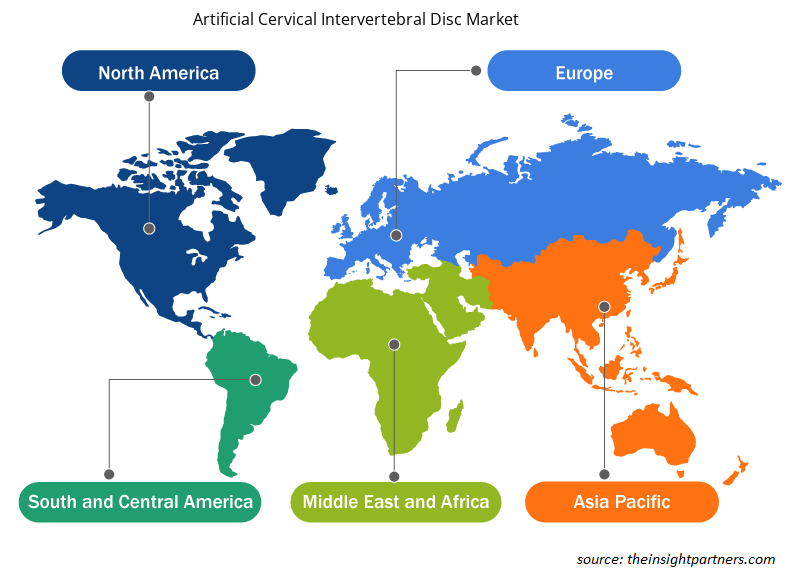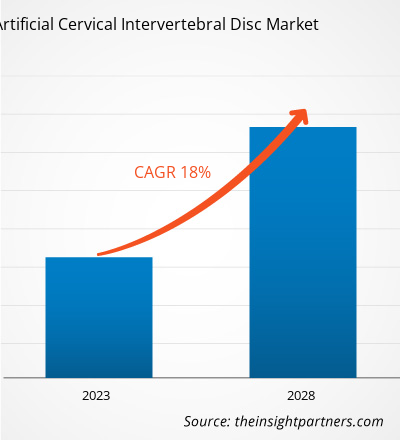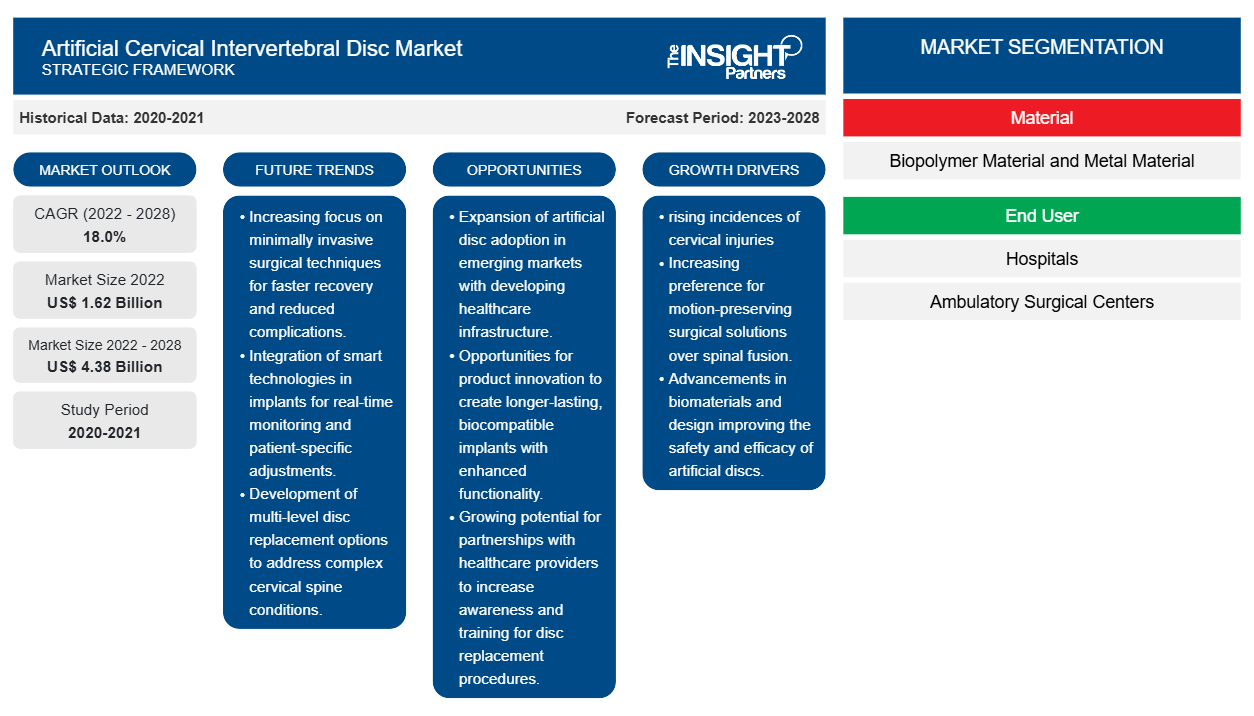[Rapporto di ricerca] Si prevede che il mercato dei dischi intervertebrali cervicali artificiali crescerà da 1.621,66 milioni di dollari nel 2022 a 4.375,29 milioni di dollari entro il 2028; si stima che crescerà a un CAGR del 18,0% dal 2022 al 2028.
La crescita del mercato dei dischi intervertebrali cervicali artificiali è attribuita alla crescente prevalenza di lesioni cervicali. Il trauma è la causa principale delle lesioni cervicali, tra cui incidenti stradali, traumi penetranti o contusivi, cadute e lesioni sportive o subacquee. Secondo lo studio "Stima del numero di lesioni cervicali correlate a incidenti stradali negli Stati Uniti: un'analisi e un confronto dei dati nazionali sugli incidenti e sugli ospedali", pubblicato nel 2020, negli Stati Uniti, ogni anno negli ospedali vengono osservate circa 869.000 lesioni cervicali correlate a incidenti stradali, di cui circa 841.000 sono distorsioni/stiramenti (colpo di frusta), 2.800 sono lesioni del disco spinale, 23.500 sono fratture, 2.800 sono lesioni del midollo spinale e 1.500 lussazioni. Inoltre, la maggior parte delle lesioni sportive sono lesioni ortopediche, tra cui stiramenti, distorsioni, fratture, legamenti rotti, dolore e gonfiore; queste possono essere acute o croniche. Secondo Stanford Children's Health, circa 30 milioni di giovani e bambini negli Stati Uniti praticano sport ogni anno e ogni anno vengono segnalati più di 3,5 milioni di infortuni correlati allo sport. Una frattura cervicale è il risultato di un trauma ad alta energia, come una caduta durante la ginnastica, l'hockey, il football o i tuffi. L'incidenza di fratture è elevata negli atleti. Secondo Spinal Cord Injury Facts and Figures at a Glance, 2020, negli Stati Uniti, circa il 7,8% delle lesioni totali del midollo spinale (SCI) sono dovute allo sport. Secondo la US Consumer Product Safety Commission (CPSC), nel 2018, circa 23.720 fratture del collo sono state trattate nei pronto soccorso degli ospedali negli Stati Uniti; di queste, circa 3.194 fratture erano dovute allo sport. L'incidenza degli infortuni sportivi aumenta con l'aumento della partecipazione allo sport e la partecipazione attiva ad attività di fitness a causa della crescente attenzione a uno stile di vita sano in tutto il mondo. Inoltre, secondo il National Spinal Cord Injury Statistical Center, le immersioni sono la quinta causa principale di gravi lesioni al midollo spinale cervicale. Pertanto, la domanda di dischi intervertebrali cervicali artificiali è in aumento a causa della crescente incidenza di lesioni cervicali.
Il disco intervertebrale cervicale ha la capacità di assorbire un enorme carico compressivo, fornendo al contempo diversi tipi di movimento tra le ossa del collo. Gli operatori del mercato hanno sviluppato diversi dischi intervertebrali cervicali artificiali che vengono utilizzati per trattare i problemi del disco cervicale. Il disco cervicale artificiale sostituisce il movimento e la funzione di ammortizzazione del disco cervicale danneggiato.
Personalizza questo report in base alle tue esigenze
Riceverai la personalizzazione gratuita di qualsiasi report, comprese parti di questo report, o analisi a livello nazionale, pacchetto dati Excel, oltre a usufruire di grandi offerte e sconti per start-up e università
-
Scopri le principali tendenze di mercato in questo rapporto.Questo campione GRATUITO includerà analisi di dati che spaziano dalle tendenze di mercato alle stime e alle previsioni.
Approfondimenti di mercato
L'aumento della popolazione geriatrica spinge il mercato dei dischi cervicali intervertebrali artificialiIntervertebral Cervical Discs Market
Il processo di invecchiamento colpisce la colonna cervicale, il collo, le spalle, la parte superiore della schiena e le braccia. La spondilosi cervicale è un termine per l'usura legata all'età dei dischi spinali nel collo. È una malattia comune e peggiora con l'età. Secondo l'American Academy of Orthopaedic Surgeons, circa l'85% delle persone con più di 60 anni è affetto da spondilosi cervicale. Con l'età, i dischi vertebrali, che fungono da ammortizzatori, si seccano gradualmente e ne influenzano la resistenza. Secondo il Fact Sheet: Aging in the United States, si stima che il numero di individui di età pari o superiore a 65 anni raggiungerà circa 95 milioni entro il 2060 dai 52 milioni del 2018 e la sua quota nella popolazione totale probabilmente salirà fino al 23% dal 16%. Inoltre, secondo il rapporto "Later Life in the UK 2019 - Age UK", circa 12 milioni (11.989.322) di persone di età pari o superiore a 65 anni nel Regno Unito, di cui 5,4 milioni di persone hanno 75 anni o più e 1,6 milioni hanno 85 anni. Inoltre, il Giappone è un'altra nazione che invecchia, con il 28,7% della sua popolazione che ha 65 anni o più. La società "super-anziana" del paese è la più anziana al mondo. Pertanto, è probabile che la crescente popolazione anziana aumenti la domanda di dischi intervertebrali cervicali artificiali.
Approfondimenti basati sui materiali
In base al materiale, il mercato dei dischi intervertebrali cervicali artificiali è stato diviso in materiale biopolimerico e materiale metallico. È probabile che il segmento dei materiali biopolimerici deterrà una quota maggiore del mercato nel 2022, la crescita è attribuita principalmente alla biocompatibilità e alla facilità di inserimento offerte dai dischi in materiale biopolimerico. Tuttavia, si prevede che il segmento dei materiali metallici registrerà un CAGR maggiore nel mercato durante il 2022-2028.
Gli operatori del mercato dei dischi intervertebrali cervicali artificiali adottano strategie organiche come il lancio e l'espansione del prodotto per espandere la propria impronta e il portafoglio prodotti a livello globale e soddisfare la crescente domanda. Gli sviluppi delle aziende nel mercato globale dei dischi intervertebrali cervicali artificiali sono stati caratterizzati come sviluppi organici e inorganici. Le strategie di crescita organica adottate dagli operatori del mercato includono il lancio e l'espansione del prodotto. Le strategie di crescita inorganica osservate nel mercato dei dischi intervertebrali cervicali artificiali erano partnership e collaborazioni. Queste strategie di crescita hanno consentito agli operatori del mercato di espandere le proprie attività e migliorare la propria presenza geografica. Inoltre, strategie di crescita come acquisizioni e partnership hanno contribuito a rafforzare la base clienti dell'azienda e ad aumentare il suo portafoglio prodotti. Gli sviluppi organici detengono l'80,95% degli sviluppi strategici totali nel mercato, mentre le strategie inorganiche rappresentano il 19,05% della crescita delle aziende.
Il mercato dei dischi intervertebrali cervicali artificiali è stato segmentato come segue:
Il mercato dei dischi intervertebrali cervicali artificiali è segmentato in base al materiale e all'utente finale. In base al materiale, il mercato è biforcato in biopolimero e metallo. Il mercato globale dei dischi intervertebrali cervicali artificiali, in base all'utente finale, è segmentato in ospedali, centri chirurgici ambulatoriali e altri.
Approfondimenti regionali sul mercato dei dischi intervertebrali cervicali artificiali
Le tendenze regionali e i fattori che influenzano il mercato dei dischi intervertebrali cervicali artificiali durante il periodo di previsione sono stati ampiamente spiegati dagli analisti di Insight Partners. Questa sezione discute anche i segmenti e la geografia del mercato dei dischi intervertebrali cervicali artificiali in Nord America, Europa, Asia Pacifico, Medio Oriente e Africa e America meridionale e centrale.

- Ottieni i dati specifici regionali per il mercato dei dischi intervertebrali cervicali artificiali
Ambito del rapporto di mercato sui dischi intervertebrali cervicali artificiali
| Attributo del report | Dettagli |
|---|---|
| Dimensioni del mercato nel 2022 | 1,62 miliardi di dollari USA |
| Dimensioni del mercato entro il 2028 | 4,38 miliardi di dollari USA |
| CAGR globale (2022 - 2028) | 18,0% |
| Dati storici | 2020-2021 |
| Periodo di previsione | 2023-2028 |
| Segmenti coperti |
Per materiale
|
| Regioni e Paesi coperti |
America del Nord
|
| Leader di mercato e profili aziendali chiave |
|
Densità dei giocatori del mercato dei dischi intervertebrali cervicali artificiali: comprendere il suo impatto sulle dinamiche aziendali
Il mercato del disco intervertebrale cervicale artificiale sta crescendo rapidamente, spinto dalla crescente domanda degli utenti finali dovuta a fattori quali l'evoluzione delle preferenze dei consumatori, i progressi tecnologici e una maggiore consapevolezza dei benefici del prodotto. Con l'aumento della domanda, le aziende stanno ampliando la propria offerta, innovando per soddisfare le esigenze dei consumatori e capitalizzando sulle tendenze emergenti, il che alimenta ulteriormente la crescita del mercato.
La densità degli operatori di mercato si riferisce alla distribuzione di aziende o società che operano in un particolare mercato o settore. Indica quanti concorrenti (operatori di mercato) sono presenti in un dato spazio di mercato in relazione alle sue dimensioni o al valore di mercato totale.
Le principali aziende che operano nel mercato dei dischi intervertebrali cervicali artificiali sono:
- Zimmer Biomet Holdings, Inc.
- Globus Medical, Inc.
- Centinel Spine, LLC
- Soluzioni per la colonna vertebrale sinergizzanti, Inc.
- Aditus Medico
Disclaimer : le aziende elencate sopra non sono classificate secondo un ordine particolare.

- Ottieni la panoramica dei principali attori del mercato dei dischi intervertebrali cervicali artificiali
Profili aziendali
- Zimmer Biomet Holdings, Inc.
- Globus Medical, Inc.
- Centinel Spine, LLC
- Soluzioni per la colonna vertebrale sinergizzanti, Inc.
- B. Braun Melsugen AG
- Aditus Medico
- AxioMed LLC
- NuVasive, Inc.
- Medtronic
- Analisi storica (2 anni), anno base, previsione (7 anni) con CAGR
- Analisi PEST e SWOT
- Valore/volume delle dimensioni del mercato - Globale, Regionale, Nazionale
- Industria e panorama competitivo
- Set di dati Excel
Report recenti
Testimonianze
Motivo dell'acquisto
- Processo decisionale informato
- Comprensione delle dinamiche di mercato
- Analisi competitiva
- Analisi dei clienti
- Previsioni di mercato
- Mitigazione del rischio
- Pianificazione strategica
- Giustificazione degli investimenti
- Identificazione dei mercati emergenti
- Miglioramento delle strategie di marketing
- Aumento dell'efficienza operativa
- Allineamento alle tendenze normative























 Ottieni un campione gratuito per - Mercato dei dischi intervertebrali cervicali artificiali
Ottieni un campione gratuito per - Mercato dei dischi intervertebrali cervicali artificiali